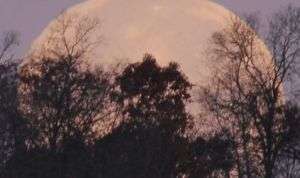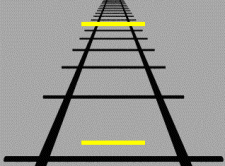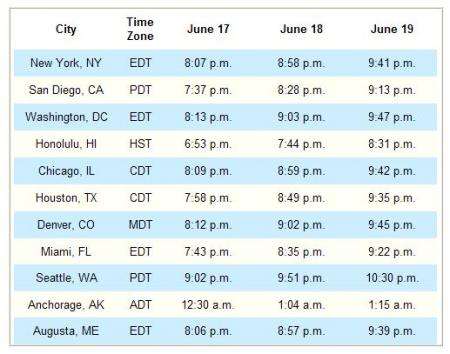Solstice Moon Illusion

Sometimes you just can't believe your eyes. This week is one of those times. On Wednesday night, June 18th, step outside at sunset and look around. You'll see a giant form rising in the east. At first glance it looks like the full Moon. It has craters and seas and the face of a man, but this "moon" is strangely inflated. It's huge!
You've just experienced the Moon Illusion.
There's no better time to see it. The full Moon of June 18th is a "solstice moon", coming only two days before the beginning of northern summer. This is significant because the sun and full Moon are like kids on a see-saw; when one is high, the other is low. This week's high solstice sun gives us a low, horizon-hugging Moon and a strong Moon Illusion.

Sky watchers have known for thousands of years that low-hanging moons look unnaturally big. At first, astronomers thought the atmosphere must be magnifying the Moon near the horizon, but cameras showed that is not the case. Moons on film are the same size regardless of elevation: example. Apparently, only human beings see giant moons.
Are we crazy?
After all these years, scientists still aren't sure. When you look at the Moon, rays of moonlight converge and form an image about 0.15 mm wide on the retina in the back of your eye. High moons and low moons make the same sized spot, yet the brain insists one is bigger than the other. Go figure.
A similar illusion was discovered in 1913 by Mario Ponzo, who drew two identical bars across a pair of converging lines, like the railroad tracks pictured right. The upper yellow bar looks wider because it spans a greater apparent distance between the rails. This is the "Ponzo Illusion."
Some researchers believe that the Moon Illusion is Ponzo's Illusion, with trees and houses playing the role of Ponzo's converging lines. Foreground objects trick your brain into thinking the Moon is bigger than it really is.
But there's a problem: Airline pilots flying at very high altitudes sometimes experience the Moon Illusion without any objects in the foreground. What tricks their eyes?
Maybe it's the shape of the sky. Humans perceive the sky as a flattened dome, with the zenith nearby and the horizon far away. It makes sense; birds flying overhead are closer than birds on the horizon. When the moon is near the horizon, your brain, trained by watching birds (and clouds and airplanes), miscalculates the Moon's true distance and size.
There are other explanations, too. It doesn't matter which is correct, though, if all you want to do is see a big beautiful Moon. The best time to look is around moonrise, when the Moon is peeking through trees and houses or over mountain ridges. The table below (scroll down) lists rise times for selected US cities.
A fun activity: Look at the Moon directly and then through a narrow opening of some kind. For example, 'pinch' the moon between your thumb and forefinger or view it through a cardboard tube, which hides the foreground terrain. Can you make the optical illusion vanish?
Stop that! You won't want to miss the Moon Illusion.

Source: Science@NASA, by Dr. Tony Phillips





















